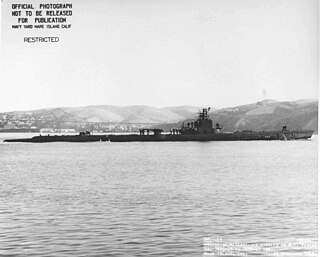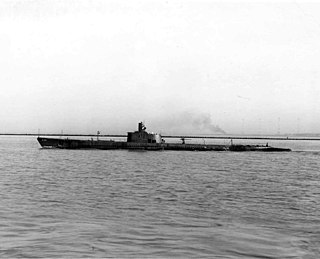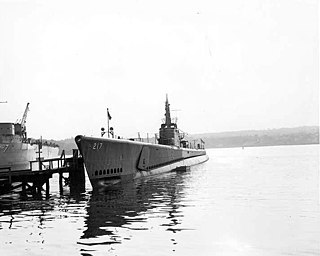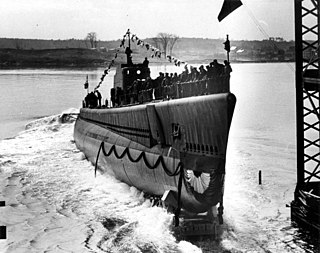
USS Bonefish (SS-223) was a Gato-class submarine, the first United States Navy ship to be named for the bonefish.

USS Bowfin (SS/AGSS-287), is a Balao-class submarine of the United States Navy named for the bowfin fish. Since 1981, she has been open to public tours at the USS Bowfin Submarine Museum & Park in Pearl Harbor, Hawaii, next to the USS Arizona Memorial Visitor Center.

USS Gar (SS-206) was the first of the Gar subclass of the Tambor-class submarines to be commissioned for the United States Navy just prior to the country's 7 December 1941 entry into World War II. These submarines were a slightly improved version of preceding submarines of the Tambor class. While Gar survived the war, all of her sister ships — USS Grampus (SS-207), 'USS Grayback (SS-208), USS Grayling (SS-209), USS Grenadier (SS-210), and USS Gudgeon (SS-211) — were lost. She is the only ship of the United States Navy to be named for the gar, a fish of the family Lepisosteidae.

Apra Harbor, also called Port Apra, is a deep-water port on the western side of the United States territory of Guam. It is considered one of the best natural ports in the Pacific Ocean. The harbor is bounded by Cabras Island and the Glass Breakwater to the north and the Orote Peninsula in the south. Naval Base Guam and the Port of Guam are the two major users of the harbor. It is also a popular recreation area for boaters, surfers, scuba divers, and other recreationalists.

USS Silversides (SS/AGSS-236) is a Gato-class submarine, the first ship of the United States Navy to be named for the silversides.

USS Drum (SS-228) is a Gato-class submarine of the United States Navy, the first Navy ship named after the drum, a type of fish. Drum is a museum ship in Mobile, Alabama, at Battleship Memorial Park.

USS Sand Lance (SS-381), a Balao-class submarine, was the first ship of the United States Navy to be named for the sand lance, a member of the family Ammodytidae.

USS Guardfish (SS-217), a Gato-class submarine, was the first ship of the United States Navy to be named for the guardfish.

USS Flying Fish (SS/AGSS-229), a Gato-class submarine, was the first submarine and second ship of the United States Navy to be named for the flying fish. Flying Fish is credited with having sunk a total of 58,306 tons of Japanese shipping and received 12 battle stars for World War II service.

USS Kingfish (SS-234), a Gato-class submarine, was the first ship of the United States Navy to be named for the kingfish.

USS Seahorse (SS-304), a Balao-class submarine, was the first submarine and second ship of the United States Navy to be named for the seahorse, a small fish whose head and the fore part of its body suggest the head and neck of a horse.

USS Plaice (SS-390), a Balao-class submarine, was a ship of the United States Navy named for the plaice, one of the various American flatfish; summer flounder. She participated in the Pacific War campaign of World War II, receiving six battle stars for her service. The United States later transferred her to Brazil in a joint cooperation program.

Piti is a village located on the central west coast of the United States territory of Guam. It contains northern and eastern coastlines of Apra Harbor, including Cabras Island, which has the commercial Port of Guam and the island's largest power plants. Piti was a pre-Spanish CHamoru village and, after Spanish colonization, became the primary port town on Guam. The town was largely destroyed during the 1944 liberation of Guam and the population relocated during the wartime construction of Apra Harbor.

SMS Cormoran or SMS Cormoran II was a German armed merchant raider that was originally a German-built Russian merchant vessel named Ryazan. The ship was active in the Pacific Ocean during World War I. Built in 1909, she was captured by the German light cruiser SMS Emden on 4 August 1914 and converted into a raider at the German colony Kiautschou. She was forced to seek port at Apra Harbor on the U.S. territory of Guam on 10 December 1914. The United States, then declared neutral in the war, refused to supply provisions sufficient for Cormoran to make a German port. After the U.S. declaration of war on April 6, 1917, the Naval Governor of Guam informed Cormoran that she would be seized as a hostile combatant, prompting her crew to scuttle her.

The MV Kinai Maru was an 8360 gross ton freighter built by Mitsubishi Shipbuilding & Engineering Company Ltd, Nagasaki, Japan, in 1930 for Osaka Shosen Kaisha for the Yokohama-New York City cargo run.

The Scuttling of SMS Cormoran off Guam on April 7, 1917 was the result of the United States entry into World War I and the internment of the German merchant raider SMS Cormoran. The incident was the only hostile encounter between United States and German military forces during the Pacific Ocean campaign of the war.

Aratama Maru (Kanji:新玉丸) was a merchant ship of the Empire of Japan. Launched in 1938, she was pressed into service as a munitions transport in World War II. She was struck by a torpedo fired from USS Seahorse on April 8, 1944, while approaching Guam as part of a Japanese ammunition resupply convoy. Engulfed in flames, her crew abandoned her and were picked up by an escort vessel. After drifting for three days, the abandoned hull came to rest just inside the reef fringing Talofofo Bay on Guam's southeastern coast. While resting on the reef she split in half with the stern of the ship drifting off of the reef toward the Mariana Trench. The wreck was partially salvaged shortly afterward and was further salvaged in the 1960s, leaving only the hull remnants, the anchor with chain, and some elements of its superstructure. It has also been the subject of souvenir diving, and its position and condition have been affected by several typhoons. Seahorse damaged Kizugawa Maru in the same attack, which was towed into Apra Harbor for repairs and during a second American bombing attack was sunk where she remains today.

Recreational dive sites are specific places that recreational scuba divers go to enjoy the underwater environment or for training purposes. They include technical diving sites beyond the range generally accepted for recreational diving. In this context all diving done for recreational purposes is included. Professional diving tends to be done where the job is, and with the exception of diver training and leading groups of recreational divers, does not generally occur at specific sites chosen for their easy access, pleasant conditions or interesting features.

Kizugawa Maru, or Kitsugawa Maru, is a World War II-era Japanese water tanker sunk in Apra Harbor, Guam. Damaged by a submarine torpedo attack off Guam on April 8, 1944, she was towed into port for repairs. In port, she was further damaged in three separate U.S. air attacks during the Mariana and Palau Islands campaign. Deemed irreparable, Kizugawa Maru was scuttled by shore guns on June 27, 1944. The shipwreck is now a deep recreational diving site.





















